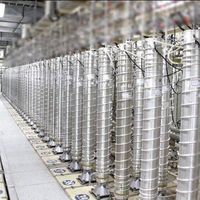Parliament Admits Iran’s Economic Limbo Will Exacerbate Poverty
Iran’s Parliament Research Center says the limbo in the regime’s economic policies will lead to further poverty and inflation in the country.
In its latest report released this week, the research arm of the Iranian parliament said that if the economic trends of the last decade continue, no policies in the country's seventh national development plan would help curb the growing poverty.
“In order to realize high growth and improve productivity, policymakers should stop price suppression policies to control inflation and solve the inflation problem in a more fundamental way," read the report. The regime tends to put a cap on prices of certain goods and services, but there is little enforcement.
According to the report by the parliament’s research center, which had said late in May that the population below the absolute poverty line in the country increased to 30.4% in 2021, the household income has not improved in the past decade and is set to become worse. Economist Farshad Momeni said a few days ago that the population of the poor has doubled in less than three years since in comparison with the average poverty in the 2010s. At that same time, the regime set a target of 116-percent growth until 2020 but the economy only grew about nine percent.
Since the 1940s Iran has launched 11 plans to build infrastructure, establish key industries, expand public services and education. Five plans were launched under the monarchy until 1979, and six during the Islamic Republic. Nevertheless, Iran is still considered a developing country, due to anemic growth in the past 44 years.
Annual growth since 1979 has barely averaged 2.5 percent, and it past decade growth has been zero, impacted by international and US sanctions related to Iran's nuclear program.
According to a report published by ILNA in January, one-third of the country’s population is now living in extreme poverty, after the number almost doubled in one year from 2020 to 2021. However, it is believed that the number could in reality be far higher. According to official figures released by the interior ministry, around 60 percent of the 84 million Iranians live under the relative poverty line of whom between 20 to 30 million live in "absolute poverty".
There have been several factors hindering Iran's economic development dating back decades. The revolutionary chaos of the early 1980s, immediately followed by the eight-year Iran-Iraq war that caused hundreds of thousands of casualties, derailed Iran from its modernization trajectory. The Islamic government, built on an anti-Western ideology engaged in hostage taking and supporting militant groups from its very inception, has left the country isolated.
The inefficiency of successive clerical governments during the past four decades, and many years of international sanctions that have crippled the country's economy, were acknowledged in the report to have contributed as adverse factors against growth.
The parliament’s research center also admitted that “foreign exchange resources have become the Achilles heel of Iran's economy, and the realization of sustainable growth depends on the provision of new foreign exchange resources for the country.”
Crushed by numerous rounds of sanctions by the US, EU, UK, and several others, the Islamic Republic faces crippling obstacles to cash its oil and gas revenues in foreign currencies, leading to tens of billions of dollars of assets frozen in foreign banks.







